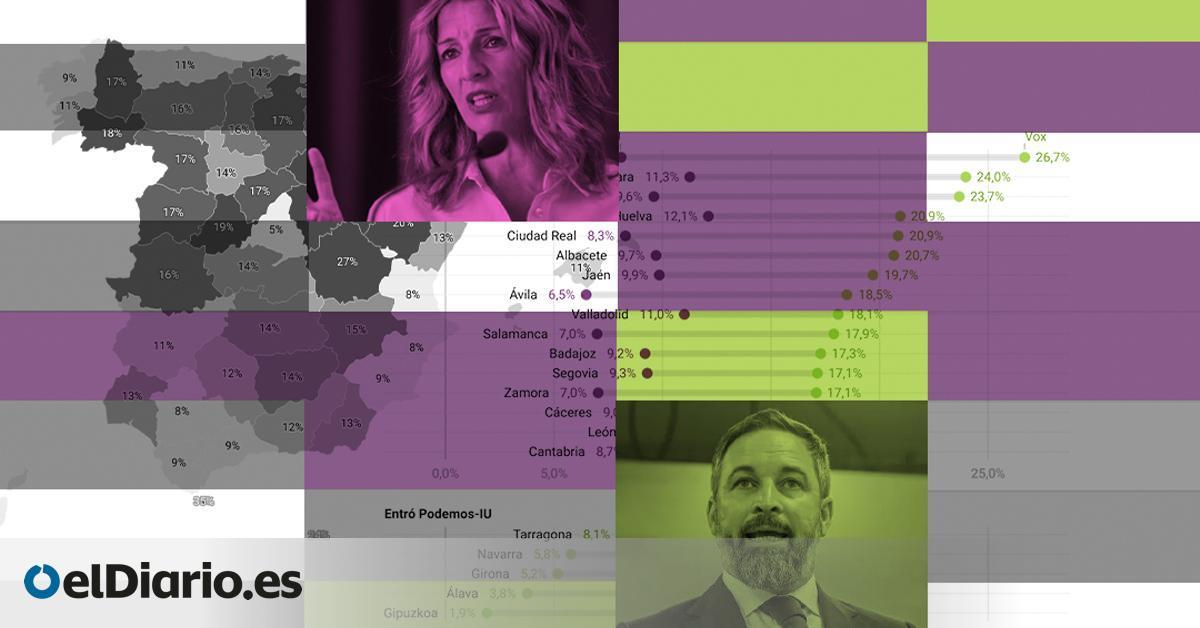
On July 23 there will not be a national election but 52 provincial ones. A multiple game in which, if everything looks like what the polls show, it will essentially be played on two boards: the one that will face PSOE and PP for the victory and a second in which Sumar and Vox will fight for the third and fourth position. In an electoral system like the Spanish one, prepared for bipartisanship, a fluctuation of just a few points can sink or trigger the parties that play that second game, key to determining if a progressive coalition government can be repeated or if institutional power remains in hands of the right and the extreme right.
The left turns against the PP and Vox pacts to try to reverse the polls one month after 23J
Further
Most of the polls carried out so far give a comfortable victory to the Popular Party of Alberto Núñez Feijóo, which according to some averages is around 140 seats; followed by the PSOE, which would drop to 100. Sumar and Vox are fighting for third and fourth position in percentages ranging from 10% to 15%, but it is difficult to calculate their result without addressing each of the constituencies that distribute seats, especially the medium and small ones, where the fight is much tighter and the cost of each deputy, much higher in votes. Sumar could be tied with Vox in votes, and even higher, but earn far fewer seats than the extreme right or vice versa.
“Right now, forecasting national results is shooting a triple without looking. It is very difficult to make a real projection of seats because you do not know if Vox is, for example, second in some small constituencies or does not get anything ”, points out David Campo, Master in Political Analysis from the Open University of Catalonia, author of a recent article by Piedras de Papel together with his colleague Guillermo Fernández Vázquez in which they advance, along these lines, that the departure of 23J may be less decided than some surveys indicate.
We must go into detail about what can happen in each of the 52 constituencies (50 provinces + Ceuta and Melilla) or at least in three types of provinces: the large ones, which distribute more than eight seats; the averages, between five and six deputies, for example; and the small ones, with less than five. The question can be put in another way: how many parties can get to enter the distribution of seats in each of these squares.
This distribution does two things. One, that the smallest provinces are overrepresented while the largest, such as Madrid, Barcelona, Valencia or Seville, are practically proportional. As can be seen in the map above, almost half of the constituencies are small, that is, they allow less than three parties in each election (if we look at what happened in the last four elections). Most of these provinces fit into what is usually defined as emptied Spain: Soria, for example, distributes two deputies; Cuenca distributes three but traditionally they remain between two parties. Huesca, Teruel, Palencia, Zamora or Ávila distribute three deputies, sometimes between two parties and sometimes between three.
Between the largest provinces (very proportional) and the smallest (not at all proportional) there is an intermediate group of circumscriptions that distributes between five and six seats, but where four parties do not necessarily always enter. They are about fifteen provinces such as Valladolid, A Coruña, Pontevedra, Cantabria, Navarra, Álava, Gipuzkoa, Girona or Castellón. Or Badajoz, where the fight is for six seats, but where on several occasions in recent years those deputies have concentrated on three parties and the fourth has been left out.
In the provinces that elect up to four seats, only 3 parties enter the cast
Number of deputies from each candidacy obtained in the last four general elections
Analysis of what has happened in recent years in the smaller provinces leaves some clear conclusions. The main one is that Sumar would not, in principle, have great options to scratch seats in the smallest (three or less) but not much chance in those of four: not even Unidas Podemos in 2016, when it won 71 seats throughout the country, managed to penetrate in these territories, with exceptions such as Burgos, León or Lleida. In the last elections, of these 21 small provinces, it only won one seat in Álava.
On the other hand, Vox in the last elections or before Ciudadanos did achieve greater penetration in these territories. The extreme right managed to sneak into provinces such as Albacete, Burgos or León. He won seats in almost half of these territories, in an election in which he won 52 seats at the national level. “Center-right parties tend to be less harmed by the electoral system, which is why it is said that the system has a conservative bias,” recalls Carlos Fernández Esquer, author of the book ‘Regional electoral systems in multi-level states’. “In the provinces of both Castillas, in emptied Spain, in rural areas… there it seems that Vox competes with Sumar, which is a confluence that usually has better results in large cities,” he points out, comparing the results of Unidas Podemos in the past.
In the medium-sized provinces, the battle is to enter the distribution
Number of deputies from each candidacy obtained in the last four general elections
The most interesting scenario in these elections will be in the medium-sized constituencies, where the fight between the third and fourth to enter the distribution of seats will be more intense. “Actually, the thing is not so much who is in third or fourth position, who has the most votes, but to reach a sufficient percentage of votes in each constituency,” says Fernández Esquer. “There are some twenty provinces where the third party, if it is above 12%, is contesting the last and penultimate seat with different actors,” says Campo.
The competition is multi-party, explains Campo, because in these larger provinces the party that fights for the last seat can do so against the party with the most votes, which can opt for a third seat; or with the second, if the fight is more even. This is what happened to Unidas Podemos in the period between 2016 and 2019, for example in Jaén or Huelva, where the strength of the PSOE and the entry of Ciudadanos (or Vox in the electoral repetition) left the coalition without a seat. In Castellón, United We Can got the last deputy on 10N. A growth of the PSOE, the PP, which then only took one, or Vox, could leave Sumar without a seat in these elections.
If Sumar were to follow the results of Unidas Podemos in 2019, as the most optimistic polls now suggest, it would be fighting for the last positions of several of these medium-sized constituencies, although given the setback of Vox, which the polls also anticipate, the fight could still be tougher, not so much with the extreme right but with the PSOE or the PP for those additional seats. A fight between the bipartisanship and the new parties.
In what percentage of the vote will the fight between the third and the fourth be fought? The legal voting threshold is the same for all constituencies, according to the electoral law: 3%. In other words, according to the law, from that percentage a party could obtain representation, but the distribution of seats by province raises, in some cases considerably above, the number of votes necessary to win seats. In the case of the more proportional constituencies, the threshold is close to the legal one: 4% in the case of Barcelona and 5% in that of Madrid. But the limit rises to 27% in Cuenca or 24% in Soria, with three and two deputies at stake. Or 35% in Melilla, where there is only one at stake.
But in the medium constituencies, where the core of the party is between the third and fourth, the threshold is also relatively high, between 11 and 16%, which would force these parties to be located in average percentages around 13%. , just where the average polls currently place them. “The average number of polls until Sumar broke in placed UP at 10%, but since then Sumar has risen two or three points and that makes them competitive in a lot of provinces,” says Campo. “Right now they are tied, if the trend continues in the next month, with Sumar going up one and a half points and Vox going from 13.5 to 12, we are in a radically different scenario,” he exemplifies.
An example that shows how hard-fought the third place can be is a comparison of what happened with Unidas Podemos and Vox between the April and November 2019 elections. In the first, the confederal group won 42 seats and 14.31% of the votes at the national level; the extreme right, 24 seats and 10.26%. Then, those of Santiago Abascal were on the verge of achieving one more seat in fifteen provinces, in most with not inconsiderable percentages such as 16.5% in Guadalajara, 14% in Cuenca, 12% in Castellón or 12 .8% in Huelva.
A few months later the tables were turned: Vox removed 52 deputies and Unidas Podemos, with 35, stayed in 15 provinces as the first party that did not win a seat. Although with a lower percentage: it happened in Huelva, where months before he had won a seat. He was left out with 12.1% of the votes, 0.8 less than what they got a few months before, when the duel between the two parties was decided by just 300 votes. This situation could be repeated in a large part of the medium-sized provinces if the two parties obtain similar percentages of the vote.
The struggle between the parties was less disputed in November 2019, precisely because Vox made the most of the collapse of Ciudadanos and the scarce bellows of Pablo Casado’s Popular Party. The advantage between Unidas Podemos and Vox was about 400,000 votes, but the extreme right managed to snatch 15% of the votes and scratch fifty seats. But again, the overall photo is misleading.
In provinces with between three and six seats, the difference between Vox and Unidas Podemos was quite large in percentage of votes. In Almería, for example, the extreme right obtained 26.7% of the votes while those of Pablo Iglesias barely reached 8.1%. In Guadalajara, 24 to 11; in Ávila, from 18.5 to 6.5. In all of them, Unidas Podemos barely managed to exceed 10%, that threshold at which the electoral system begins to punish more harshly. “Historically, the parties that have been below 15% have begun to be punished by the system, but when you go below 10% it begins to punish you a lot,” says Fernández Esquer.
In those elections, those of November 2019, Unidas Podemos resisted in communities where it has traditionally had many votes: Euskadi, Navarra, Catalonia. And there a reverse situation occurred. The confederal group obtained reasonable percentages, above 15% (except in Girona or Tarragona), but what made the difference was Vox’s poor performance in those territories, where that force has had little entry capacity until now.
The polls show that on July 23 there will be a concentration of the vote in the two big parties that has not been observed since before 2011, with the Popular Party and the PSOE tying close to 60% of the votes. And a tight fight between the other two major parties that, depending on all these variables, can opt for one side or the other. It is not so important who comes in third or fourth place but the strength with which those parties are placed in the key constituencies.
——————————–
we need you more than ever
The electoral result of the municipal and regional elections leaves no room for doubt. A reactionary wave is coming and most of the media are swimming in the same direction. elDiario.es has become one of the few leading newspapers, with the ability to set the agenda and uncover exclusive investigations, which remains independent and is not captured by the right.
If you believe that journalism matters and affects our lives, please support us. Today we need you more than ever. Become a member, become a member, of elDiario.es
Source: www.eldiario.es

